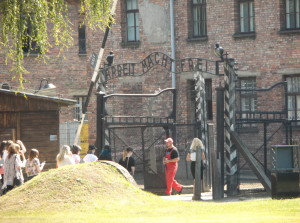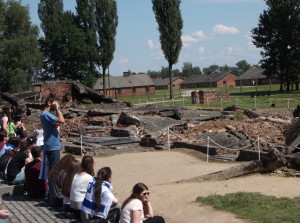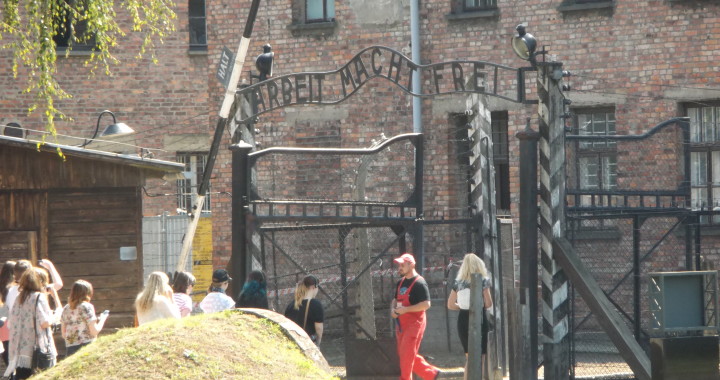
At perhaps the most well known of all concentration camps, Auschwitz – Birkenau was perhaps the most impactful of our experiences in Poland. We started the day at Auschwitz I, which was as much of a museum as it was a complete picture of what life was like there. Entering through the iconic gates that say “work will set you free”, we saw exhibits detailing the vast distances people were transported to get to the camp, as well as a picture of the different bunking conditions throughout the camp’s history (in case you were wondering, inmates started out sleeping on straw, which were later “upgraded” to mats, and eventually bunks, which were still extremely overcrowded).
We entered the new Jewish building, which focused on the lives of individual Jews before and during the war. The first room was filled with projections on the walls filled with videos, many homemade, of Jews with their families and friends. Upstairs, we entered the propaganda room, which displayed speeches from various Reich leaders translated on a series of screens demonizing the Jewish people. The next room was a simple design, with real children’s artwork drawn like pencil sketches on white walls from pre-war times. It was heartbreaking to imagine all of the young lives lost, and the potential they had to change the world wasted. The last room was the hall of names, where they had listed in a giant book like display the known names of 4 million+ that perished in the holocaust.
As we left the building, our guide Jules so poignantly stated, “When Jews arrived at Auschwitz, their names were replaced by numbers. It’s exhibits like this, and people like you, that give those who perished their names back.”
Birkenau was another experience entirely. This enormous death and labor camp, which had 4 crematorium, is quickly deteriorating to the point that if preservation measures aren’t enacted soon, any remaining structures may be reduced to rubble as many structures already have.

We grow up learning about the holocaust, and are told to never forget, but it’s not until the fragility of human life and remnants of the holocaust are experienced can we really gain an understanding for the importance and urgency of holocaust education.
We must teach. We must experience. We must teach the value of human life to our children. And we must never forget.

